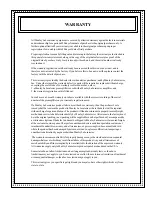
BIAS PROCEDURES
The Manley Studio Standard 350 is a fixed bias system that requires very little attention. If you wish to
adjust or check the bias, follow the following steps.
1.
On diagram 1, which depicts the front panel of the Manley 350, you can see two measurement
tip jacks labled "READ BIAS". Place the probes of a standard volt meter in these sockets and set the
volt meter to read 'millivolts'.
2.
Directly below these tip jacks is a knob labeled with sixteen points. Since the Manley Studio
Standard 350 only has 8 output tubes, only half of these sixteen positions can be obtained. The switch
when set at 1 o'clock will read output tube ones's voltage drop across the cathode resistor. Simularly,
as you continue clockwise you will continue until you reach tube eight's bias voltage.
3.
On diagram 2, which depicts the top view of the Manley 350, you will see the tube numbering
sequence and the bias adjust pots used to alter the bias of each tube.
4.
The first step to setting the bias is to turn on the amplifier and ensure that there is zero signal
input. Also, leave your loadspeakers connected as these provide an ideal load on the output. It is
recommended that tha you leave the amplifier on long enough to ensure that the tubes have reached
their stable current draw.
5.
Set the switch to the one o'clock position and adjust the first trim pot (furthest left) until you
measure 300 to 350 mV. Since you are measuring across a 10 ohm cathode resistor, this would
correspond to 30 to 35 mA of bias current.
6.
If you are unable to bring the bias down to 30 to 35 mA on any tube then we recommend that
the tube be carefully watched or replaced.
7.
Follow step five with the remaining tubes. Once they are all set, your amplifier should be in
perfect operation.
NOTE: There are two red tip jacks and one pot on the top of the amplifier which should not be
altered. These tip jacks are used to measure the AC balance which is factory set and should never need
adjustment.





























